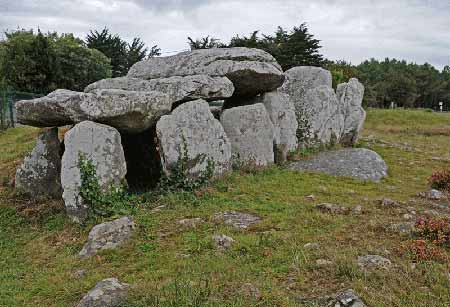濒临大西洋的卡纳克是位于法国布列塔尼半岛一个神秘的小镇。它的郊外散布着一片片整齐排列的石阵,在长达8千米的范围内到处是林立的巨石,这就是著名的卡纳克石阵,被英国考古学家海丁翰教授称为“比金字塔更神秘”的石柱群。

By Colleen Mart
穆阳 选 胡晓凯 译
|
Reminiscent of Stonehenge[1], upright stones dot the French landscape of the area we know as ancient Brittany. Surrounding the tiny village of Carnac, France, they became known as the Carnac stones. More than 3,000 stones, standing in defined rows, obviously are not the product of natural phenomena. In fact, scientists have determined that they were cut from rock found in the area and erected[2] by humans between 4,500 and 2,000 B.C. In recent centuries, many of the sites have been neglected[3], with reports of the stones being used as sheep shelters, chicken sheds or even ovens. Even more commonly, stones have been removed to make way for roads, or as building materials. The continuing management of the sites remains a controversial topic. Major archaeological[4] interest in the stone rows only happened in the latter half of the 20th century. These archaeologists originally believed that rather than a series of stone rows, there was in origin just one major stone row, covering a distance of more than eight kilometres. Soon, research revealed that this “single stone row” theory did not hold water[5]; it seemed that there were mainly three stone rows, each containing approximately 1,000 stones. One such concentration of stones can be found near Erdeven; the other concentration of stones stands back to the north of Carnac. The most western is that of Menec, where there are 1,099 standing stones in 12 rows. One stone towers above[6] all others, and is thus labelled “the giant”, measuring 3.70 metres. Most of the stones are, however, relatively small, in comparison to the stone row of Kermario, to the east of the row of Menec. Kermario counts 1,029 stones, distributed in ten rows. The field measures 1,120 metres, showing that the stones are roughly one metre apart. This field has the most gigantic[7] stones, and is continued in the field of Kerlescan, where there are 594 stones, in 13 rows and over 880 metres. All three fields are constructed on the same principle: the tallest stones are located on the western side; the western side is also situated on higher ground than its eastern counterpart. The smaller stones on the eastern side are also at smaller intervals from each other. Archaeologists have excluded the possibility that these are graves. Neither did they serve a military purpose, though the American soldiers, during the Second World War, did mistake the stone rows for a German defence line. According to the legend, a French soldier who was aware of the situation had to intervene, as otherwise the stone rows would have become the target of intensive bombing raids. Excluding funerary and military purposes, archaeologists conclude that the only purpose could have been religious. Many researchers agree that the megalithic[8] civilisation worshipped nature, and possibly the sun in particular. Some argue that megalithic complexes are astronomical observatories. But whereas impressive research has been done on this aspect, the most basic aspect of this research time and again reveals a particular focus towards the sun. Carnac is an ideal location for any solar worshipper. The sun makes an appearance almost every day, as the area is blessed with a micro-climate. Situated at the coast of Brittany, it is located at the site where the Gulf Stream hits the European continent. Carnac is furthermore shielded by a peninsula, known as the Presqu’ile de Quiberon. Carnac is therefore proud of its 2,053 hours of sun per year, which from April results in 7 hours of daily sunshine. That we found a series of impressive stone rows in exactly this location, could therefore suddenly be easily explained. Further evidencefor such a theory can be found in the fact that the micro-climate of the Bay of Quiberon ends to the north of Erdeven—which is where the stone row of Kerzerho is situated. There are no stone rows to the north of this. Apart from massive stone rows, other impressive stone monuments can be found in the area. This includes one standing stone, which was twenty metres high, weighed in at 340 ton and was moved over a distance of six kilometres. It should come as no surprise that this stone is no longer standing. But this stone does underline the knowledge and technology of a culture that was able to perform such feats.[9] It also underlines that moving and building with large stones was a well-versed[10] knowledge in Western Europe, a thousand years before the ancient Egyptians began to construct their stone monuments along the river Nile.
|
在法国的古布列塔尼地区,遍布着一片片石柱群,让人联想起英国的史前巨石阵。它们分布在法国一个名为卡纳克的小镇周围,被称为卡纳克巨石阵。三千多块石头整齐地排列成排,显然不是自然之力所为。事实上,科学家们已考证出,这些石头是公元前4,500到2,000年,人们从这里的岩石上切削下来并凭人力树立起来的。 近几个世纪以来,(卡纳克的)许多石阵遗址都废弃了,据说,许多石头被用来修建羊圈和鸡舍,甚至用来砌炉子。更多时候,它们因为修路被移走,或者用作建筑材料。对这些遗址的持续性管理一直是颇有争议的话题。 直到20世纪后半期,考古学家才开始对这里的巨石阵产生了兴趣。他们起初认为这些石头阵开始并不是由一系列的一排排的石阵组成,最初主要是一排八千多米长的石阵。然而,研究很快证明,这个“单排石阵”的说法站不住脚,石阵起初似乎主要有三排,每排由大约一千块石头组成。 其中一个石阵位于埃尔德旺(卡纳克地区的一个镇)附近,另一个则在卡纳克以北。位于最西部的是莫奈克石阵,共有1,099块石头,排成12排。其中一块比其他的石头都要高,达到了3.7米,因此被冠以 “巨人”之名。然而,与位于莫奈克石阵东部的克马里欧的石阵相比,这里的大部分石头仍相对较小。克马里欧石阵共有1,029块石头,排成10排,长1,120米,各排之间间距约为一米。这个石阵的石头块头最大,一直延续到克勒斯坎巨石阵附近,克勒斯坎的巨石阵包括594块石头,13排,长880多米。 这三个石阵的布阵都基于同一个原则:西边的石柱最高,地势也是西部较东部高。东边略小的石块之间的间隔也比较小。 考古学家已经排除了巨石阵是墓穴的可能性。它们的修建也并非出于军事目的,不过,在二战中,美国士兵确实曾将这些石阵误认为是德国的防御工事。据传,如果不是一个知情的法国士兵加以阻止,恐怕这些石阵已经成为炸弹密集轰炸的目标了。 既然排除了墓穴和军用的可能性,考古学家断定,它唯一的用途可能就是宗教崇拜。许多研究者都有共识,巨石文明崇拜自然,尤其崇拜太阳。一些人认为,巨石阵乃是天文台。然而,这方面的大量研究一次又一次地表明巨石阵与太阳有紧密关联。 对于任何太阳崇拜者来说,卡纳克都是一个理想之所。这里,太阳几乎每天都会露面,因为这里具有一种(独特的)微气候。卡纳克位于布列塔尼海岸,是墨西哥湾与欧洲大陆的会合处。它还受到一个名为“基伯龙”的半岛的庇护。因此,卡纳克每年都得以拥有2,053小时的光照,四月过后每天都有7小时沐浴在阳光中。而正是在这里,我们发现了令人震撼的巨石阵,一切突然变得易于解释了。对这个说法还有更多证据,克拉融海湾的微气候一直延伸到埃尔德旺北部——正是凯尔泽欧巨石阵的所在地。从此往北就再没有任何石阵出现了。 除了巨大的石阵外,这个地区还发现其他令人惊叹的石头建筑物。其中有一块矗立的石头,高20米,重340吨,被移动了6,000米的距离。难怪如今这块石头已经不再直立着了。然而,这块石头确实折射出那个能完成那一壮举的文化的知识和技术。它同样也说明,在当时的西欧,移动石头和用石头建造房屋是人们娴熟掌握的技艺,这比古埃及人开始在尼罗河边建造石头建筑要早一千年。 (来源:英语学习杂志) |
|
Vocabulary: 1. reminiscent: 发人联想的;Stonehenge: 巨石阵(英国南部索尔兹伯里附近的一处史前巨石建筑遗址)。 2. erect: 树立,建造。 3. neglect: 忽视,弃置。 4. archaeological: 考古的,考古学的。 5. hold water: 符合逻辑,站得住脚。 6. tower above: 超出,高过。 7. gigantic: 巨大的,庞大的。 8. Megalithic: (考古的) 巨石造成的,使用巨石的。 9. underline: 强调,表明……的重要性;feat: 功绩,业绩。 10. well-versed: 熟练的,精通的。 |